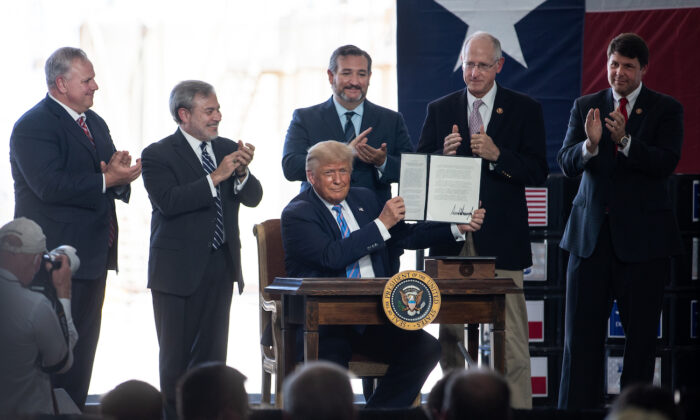Most likely: Exit Paris pact, lift LNG export permit pause, suspend offshore wind permits, expand offshore oil/gas leases, declare national energy emergency.
News Analysis
When newly-inaugurated President Donald Trump issues his anticipated broadside of 100 day one executive actions on Jan. 20, several dozen will presumably zero in on energy policy and environmental regulation.
“Energy dominance” and “drill baby drill” 2024 campaign rally chants were amplified by Trump during the post-Nov. 5 transition by reiterating his intent to issue orders that “unleash American energy” while hinting at dispensing broader directives aimed at exercising regulations imposed under President Joe Biden’s “new green scam” from federal purview.
In the mix with potential energy-related executive actions is the second Trump administration’s proposed tariff regime. How those actions unfurl, including penalties on Canadian crude oil and refined fuel, imported solar and electric vehicle battery parts, supply chains, and critical minerals, will affect actions related to energy.
Of Trump’s expected 100 inauguration afternoon pen-stroke fiats—Biden holds the record of 17 day one executive orders—there will be two general types related to energy development.
There will be those that prompt an immediate, actionable event, and those that implement policies through administrative process, rule-making, and legislation.
Day One Action Items
Oval Office housekeeping will be addressed in day one executive orders with the elimination of the White House Climate Office and adviser position created under the Biden administration and the establishment of a National Policy Council chaired by Department of Interior (DOI) Secretary nominee Doug Burgum.
Trump is also expected to withdraw the United States from the 2015 Paris Climate Accord, as he did in 2017; order the Bureau of Land Management (BLM) to move its headquarters from Washington to Grand Junction, Colorado, as he did in 2020; and renew federal approvals for the Keystone XL Pipeline, as he did in 2020 before the project was withdrawn in 2021.
Lift LNG Export Permit Pause: Trump is expected to immediately end the Biden administration’s January 2024 halt in new permit reviews by directing the Department of Energy (DOE) to approve new terminals to export liquified natural gas (LNG).
The Biden administration imposed the pause for the DOE to study LNG export effects on the economy, national security, and the climate crisis. The study, completed in December, found that “unfettered” exports could make domestic prices rise.
Although Trump has vowed to end the export pause immediately, he could wait until after the DOE’s 90-day comment period on the study ends in mid-February to address it in an executive action.
Repeal Biden’s Executive Order 14082: Any executive order can be repealed by an executive order, so this pen-stroke dissolution erases the Biden fiat that provides the authority for implementing many aspects of the 2022 Inflation Reduction Act (IRA).
Trump and Republican Congressional leaders vow to dismember the massive IRA which, along with the 2021 Bipartisan Infrastructure Law and the 2022 CHIPS & Science Act, are the signature bills of Biden’s “New Green Deal.”
The IRA alone authorizes 10 years of sustained tax credits, low-interest loans, and grant programs that by some estimates could top $1 trillion.
Untangling the IRA will require legislation and the political will do so. Some of its provisions are popular, including in Republican congressional districts.
By repealing EO 14082, the White House and Congress can administratively tighten tax credits, claw back some loans and grants, and revise unfinalized rules under the Congressional Review Act to chip away at the IRA.

Impose Moratorium on Offshore Wind Development: Trump publicly touts a visceral dislike for windmills and, despite his first administration backing offshore wind ventures, he is expected to halt proposals to develop wind power in federal waters beyond the 11 already approved to generate more than 19 gigawatts of energy, enough to power more than 6 million homes.
The new president is expected to issue an executive order at least partially crafted by Rep. Jeff Van Drew (R-N.J.) that would pause offshore wind development between Rhode Island and North Carolina for six months so the DOI can review permits issued to projects.
There could also be an executive action specifically related to nixing BLM’s June Environmental Impact Statement (EIS) approval of the proposed Lava Ridge wind project in south-central Idaho.
Magic Valley Energy’s proposed 4,500-acre project with 241 660-foot-tall turbines would generate enough power for 500,000 homes but is vociferously opposed by an overwhelming majority of residents who live in the surrounding seven counties.
During Burgum’s Jan. 16 nomination hearing before the Senate Energy and Natural Resources Committee, Sen. James Risch (R-Idaho) hinted that Trump would target the project in an executive action.
“We hate windmills. We don’t want windmills,” he said, suggesting the Lava Ridge project “only has about 95 hours left on the table. [It was] a 99-to-1 issue and we’re so happy to see it gone.”
Declare a National Energy Emergency: Like he did in his first term, Trump is expected to reissue a comprehensive order declaring a national energy emergency to fast-track permits for grid infrastructure and energy projects.
Such an order could have a wide scope and will be crafted to specifics that will likely focus on infrastructure development that would benefit natural gas projects, pipeline operators, and the mining industry, especially in the context of minerals now imported and for critical minerals.
Trump hinted about the nature of such an all-encompassing order to expedite permitting and trim environmental reviews for investors financing job-creating and power-generating projects of $1 billion or more will receive “expedited approvals.”
In addition to a national energy emergency order, Trump could issue specific actions related to development proposals, such as acting on his July 2024 campaign pledge to reverse “in about 10 minutes” the Biden administration’s 20-year mining ban on 225,500 acres within Superior National Forest in northeast Minnesota.
Such an order would boost Twin Metals Minnesota’s stalled 2019 $1.7 billion proposal to extract copper nickel, and cobalt on up to 25,000 acres within the national forest that the Chilean-owned company says would employ 850 over its projected 30-year operation.

Policy Directives
Many of Trump’s Jan. 20 executive orders, actions, and directives will drive policy and unfold in the rule-making, regulatory, and legislative processes, although within this broad guidance, day one action items could emerge to spearhead “messaging” forays on the basis of impose first, debate later in court.
End the ‘EV Mandate’: Trump is expected to order the Environmental Protection Agency (EPA) to take measures to roll back the tailpipe pollution limits for cars, SUVs, and trucks sold between 2027–2032 it finalized in March, and order the Department of Transportation to revise Corporate Average Fuel Economy standards.
Within the broader context of this issue realm, Trump could issue a specific action targeting California’s ban on the sale of new gas-powered cars by 2035. The Clean Air Act allows a state to set more stringent limits on tailpipe pollution than federal standards, which the EPA acknowledged in December when it approved California’s waiver to exceed federal standards.
Many anticipate Trump will revoke California’s EPA waiver via executive order on day one.
Increase Oil, Gas Development on Federal Lands: Trump and congressional Republicans say among the swiftest and least expensive ways to “unleash American energy,” build out the grid to meet rapidly increasing electricity demand, and lower energy costs is to open more federal lands and waters to fossil fuel extraction, a component of the energy mix they say was excluded from the IRA’s unspooling incentives for renewable energy development.
That will require overhauling restrictions imposed by the Biden administration on federal oil and gas development, especially, offshore, and in areas such as Alaska, meaning Trump is likely to issue several related orders pushing regulatory reform and legislative action to address what Burgum called “imbalances” in allocations and rule-making.
Among expected actions is an executive order directing DOI to revise the five-year offshore leasing plan approved under the Biden administration that schedules just three auctions between 2024 and 2029, compared to 47 proposed during Trump’s first term. Trump is likely not only to request more auctions, but to expand auctions to new offshore regions.
Biden’s December ban on offshore drilling across 625 million acres off the east and west coasts, the eastern Gulf of Mexico, and Alaska’s Bering Sea issued under the federal Lands Act will require a legislative remedy to amend, a lesson learned during the first Trump administration when an executive order reopening Arctic drilling was nixed in a federal ruling that determined such an order needs congressional authority.
Trump is also expected to address in executive actions entanglements within the labyrinth of laws, regulations, and rules that guide federal land-use policies, including challenges to the constitutionality of the 1906 Antiquities Act used to set aside federal areas of historical, cultural or scientific importance, perhaps pricking open the debate by altering the boundaries of Bears Ears and Grand Staircase-Escalante national monuments in Utah.
It is uncertain if Trump can halt encoding BLM’s new “landscape health” conservation rule into law with an executive order on day one, but he is likely to issue policy guidance to stymie its implementation while pushing for its repeal through regulatory actions.
The pending BLM Conservation and landscape rule for public lands development reviews places conservation as a specific use, the same as grazing, timber harvesting, energy development, recreation, and other activities.
Burgum, who as North Dakota’s two-term governor sued the Biden administration for failing to meet its statutory federal land auction requirements, said as Trump’s DOI chief, “The starting place is for us to go back to is, you know, follow the law. I think that’s a pretty simple formula.”
Expand Drilling in Alaska’s ANWR/NPR: If Alaska Gov. Mike Dunleavy has his way, Trump will issue a first-day action that undoes any “actions that lock up Alaska lands and resources.”
Such an order, Dunleavy wrote in a Nov. 15, 2024, letter to Trump’s transition team, would “make both Alaska and America great again.”
Trump has made no secret of his desire to do just that by expanding fossil fuel development in Alaska’s 23-million-acre National Petroleum Reserve (NPR) and 19.6-million-acre Arctic National Wildlife Refuge (ANWR), but it is most likely going to require legislation to achieve tangible results.
The Biden administration’s March 2024 decision to allow ConocoPhillips to proceed with its $8 billion Alaska Willow Project with 219 wells across 556 North Slope acres was conditioned by its withdrawal of 13 million NPR acres from oil and gas leasing.
Trump could direct the DOI to restore those land-use designations for those NPR acres and issue an executive order adhering to his directives—and federal law—in expanding ANWR leasing.
During Trump’s first term, Congress directed DOI to open ANWR to oil and gas drilling for the first time. Under the 2017 Tax Cuts and Jobs Act, the DOI was required to conduct two annual lease auctions within Section 1002, a 1.5-million-acre coastal plain expanse that the U.S. Geological Survey estimates could hold up to 11.8 billion barrels of oil.
Instead, the administration auctioned only 400,000 acres in January, the smallest amount allowed under the law. There were no bidders, Alaska argued in a lawsuit it filed the day before the auction closed, because of “new severe restrictions on surface use and occupancy” imposed by the administration in November made “any development economically and practically impossible.”
While querying Burgum during his nomination hearing, Sen. Lisa Murkowski (R-Alaska) said she hopes Trump’s executive orders spur a culture change within federal agencies such as DOI in how they relate to constituents.
“It doesn’t do my heart any good to oftentimes refer to the Secretary of Interior as Alaska’s landlord, but we pretty much have to go to Interior to ask for permission to do anything,” she said, noting that was very much the dynamic under the Biden administration.
“I don’t want the Department of Interior to be a landlord. I want you to be a partner,” Murkowski said.

Rules, Rollbacks, Rhetoric
Revise Biden 2021 Greenhouse Gas/Power Plant Order: The EPA under the Biden administration in April 2024 finalized stringent new greenhouse gas emission standards that significantly raise costs for coal-fired power plants and those invested in newly built gas generation that utilities and electric transmission operators say could render some power plants financially inoperable.
The rule has been challenged and a ruling by the U.S. Court of Appeals for the District of Columbia Circuit is expected soon. Trump could issue an executive order directing agencies to not implement the order until the court ruling. It will require legislative action, however, to bury the greenhouse gas rule altogether.
Revise EPA Methane Rule: The EPA finalized on Nov. 12 a new methane emissions rule that levies a first-ever “waste emissions charge” on oil/gas producers via IRA provisions authorized under the Clean Air Act.
Under the IRA, companies that emit methane beyond 25,000 metric tons of carbon dioxide annually must pay $900 per metric ton in 2024, $1,200 in 2025, and $1,500 in 2026 and beyond.
Although repealing the methane emission fee will require congressional action, the emissions charge could be eliminated in budget reconciliation under the Congressional Review Act, a Trump executive action might direct agencies to not collect the data emitters are required to provide to verify compliance while legislation and court actions matriculate.
Regulatory Rollbacks/Staffing Cuts: Trump in executive orders, his appointees in administrative actions, and compliant Republican lawmakers in bills and hearings are expected to consistently challenge and chip away at the Clean Air Act, the Clean Water Act, the Endangered Species Act, and the National Environmental Policy Act (NEPA) while scrutinizing newly adopted environmental regulations such as those included in the Office of Safety & Occupational Health’s 2024 heat safety rule.
Trump is expected to reverse Biden’s order revising how habitat is defined in what will be a sustained effort to “restore” the 51-year-old Endangered Species Act to its original intent with proposed changes to how it is implemented.
NEPA reform is also likely to be decreed, if not achieved, by executive order because that, too, will require legislation, although NEPA reform is rapidly gaining bipartisan support.
Trump is likely in an executive action to support a statute of limitations on lawsuits and limiting who can legally challenge energy and infrastructure projects, among other NEPA reforms Congress is expected to approve in the coming months.
If “personnel is policy,” as they say in Washington, then personnel in agencies such as the BLM and EPA, and departments such as the 70,000-employee DOI, will know this policy well.
The EPA had 16,056 full-time permanent and temporary employees as of October 2024—about 6,200 more working at the agency than when Trump left office in January 2021. During his first term, Trump proposed trimming its annual budget by 31 percent and capping employees at 11,611.
During the campaign, Trump identified the Department of the interior as the department he’ll scrutinize most in trimming the federal workforce, noting, “The environmental agencies have stopped … you from doing business in this country,” vowing that culture will be overhauled with the installation of more than 100 presidentially-appointed policy positions within DOI.

